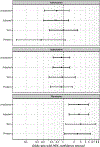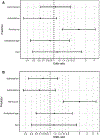Parenting style associations with sensory threshold and behaviour: a prospective cohort study in term/preterm infants
- PMID: 30790352
- PMCID: PMC7295369
- DOI: 10.1111/apa.14761
Parenting style associations with sensory threshold and behaviour: a prospective cohort study in term/preterm infants
Abstract
Aim: Early-life atypical sensory functioning and behavioural profiles are often associated with long-term developmental problems, especially in former preterm infants. We tested whether parenting style is associated with atypical sensory threshold or behavioural outcomes in preterm and term infants assessed during early childhood.
Methods: We prospectively evaluated parenting style for a cohort of term and preterm infants who had previous assessments of sensory development and behaviour. We used standardised tools to evaluate parenting style, sensory neurological threshold at one year, and internalising and externalising behavioural tendencies at two years. Covariates included gestational age, sex and maternal education.
Results: For the entire cohort (n = 82), children of more permissive parents were 2.7 times more likely to demonstrate abnormal sensory neurological thresholds compared to children of parents with less permissive styles (CI: 1.4-4.9). More permissive parenting scores were also associated with 2.4 times increased internalising (CI: 1.3-4.2) and 3.0 times increased externalising (CI: 1.6-5.6) tendencies. In the preterm group only, higher authoritative parenting scores were associated with fewer behavioural problems.
Conclusion: Permissive parenting is associated with worse infant sensory and behavioural outcomes. Authoritative parenting is associated with fewer behavioural problems in preterm children. Modification of parenting style may improve sensory development and behavioural outcomes.
Keywords: Behavioural and learning problems; Neurodevelopment; Parenting; Preterm children.
©2019 Foundation Acta Paediatrica. Published by John Wiley & Sons Ltd.
Conflict of interest statement
CONFLICT OF INTEREST
None of the authors have any conflicts of interest to disclose.
Figures





References
-
- Aylward GP. Neurodevelopmental outcomes of infants born prematurely. J Dev Behav Pediatr 2014; 35: 394–407. - PubMed
-
- Eeles AL, Anderson PJ, Brown NC, Lee KJ, Boyd RN, Spittle AJ, et al. Sensory profiles obtained from parental reports correlate with independent assessments of development in very preterm children at 2 years of age. Early Hum Dev 2018; 89: 1075–80. - PubMed
-
- Case-Smith J, Weaver LL, Fristad MA. A systematic review of sensory processing interventions for children with autism spectrum disorders. Autism 2015; 19: 133–48. - PubMed
Publication types
MeSH terms
Grants and funding
LinkOut - more resources
Full Text Sources
Medical

